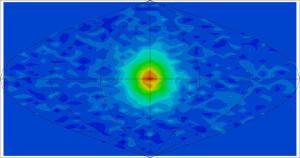Blog
Common Core
31 August 2014
 Kamioka Observatory, ICRR, University of Tokyo
Kamioka Observatory, ICRR, University of TokyoOur Sun (like other stars) is powered by nuclear reactions within its core. Part of the way we know this is through the observation of solar neutrinos. When solar neutrinos were first observed, the levels observed were less than predicted by about a factor of three, which came to be known as the solar neutrino problem. Since then we’ve come to understand that neutrinos have mass, and can change between flavors (electron, muon, and tauon), which solves the solar neutrino problem. Our neutrino detectors are good enough that we can now produce neutrino images of the Sun, such as the image above, and the rates of neutrino emission are in good agreement with solar core models.
Despite all that success, there has been one aspect of solar neutrinos that we’ve wanted to observe, but haven’t, and that is neutrinos from the Sun’s most common nuclear interaction. Nuclear fusion in the Sun is a complex process where hydrogen protons are fused into higher elements. The start of that process is the fusion of two protons, which is known as the proton-proton chain or pp-chain. The pp-chain is the most common reaction in the Sun’s core, and it provides about 99% of the energy produced by the Sun. The problem is that the neutrinos produced in this reaction have rather low energies, which makes them very difficult to detect. The solar neutrinos we’ve observed so far have been from higher order reactions such as boron decay.
Now a new paper in Nature presents the first direct detection of pp-neutrinos from the solar core.1 The results are pretty impressive, since the signal of pp-neutrinos can be masked by various sources of noise, including some from the detector itself. The team was able to isolate noise and focus their detector on a narrow energy range sensitive only to pp-neutrinos. They not only detected pp-neutrinos, but were able to confirm the rate of pp-chain reactions in agreement with solar core models.
They were also able to demonstrate that pp-neutrinos change flavor at a slightly lower rate than higher energy boron neutrinos. This implies that not only do neutrinos change flavor while moving through matter (such as during their journey out of the Sun’s core) but that neutrino flavor changing is somehow dependent upon neutrino energy. Overall this is a big result. It strongly confirms our solar fusion model, and has enough sensitivity that future data could fine tune our understanding of nuclear reactions in the solar core. It could also provide data on the mechanism of neutrino flavor changing, which is still not entirely understood.
And for fans of the electric universe, this new work hammers the last nail in the coffin of the electric Sun model. Proton-proton reaction rates depend upon the pressure, temperature and density of hydrogen nuclei. The energy and level of pp-neutrinos clearly shows that 99% of the Sun’s energy is produced in the core, and not in the corona as EU fans claim.
Bellini, Gianpaolo, et al. “Neutrinos from the primary proton–proton fusion process in the Sun.” Nature 512.7515 (2014): 383-386. ↩︎